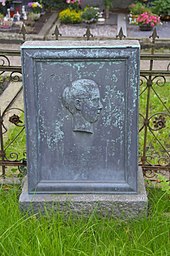Hilde Mangold
Hilde Mangold (born October 20, 1898 in Gotha as Hilde Pröscholdt ; † September 4, 1924 in Berlin) was a German biologist and embryologist who carried out the decisive experiments on the way to the discovery of the Spemann organizer (also Spemann-Mangold organizer) carried out and thus pioneered the development of embryology.
Childhood and youth
Hilde Pröscholdt was born in Thuringia in 1898 as the middle daughter of Gertrude and Ernst Pröscholdt. She had an older and a younger sister. The father had gone from a porcelain painter to an employee of a soap factory and married the daughter of the owner. The family was able to live in good circumstances thanks to good business. Hilde's mother was culturally and politically active and advocated the defense of women's rights. In the spirit of the German educated middle class, Hilde received a very good education. At the age of 16, her parents sent her to the Ernestinum Gotha grammar school , which was an exception for girls at the time. After graduating from high school in 1918, she first studied chemistry at the Friedrich Schiller University in Jena, before completing her studies with Otto zur Strassen by studying zoology in Frankfurt / Main, before moving to the university's zoological institute in 1920, where she PhD in 1923 under Hans Spemann .
Study and work
Hilde Pröscholdt studied chemistry from 1918 at the University of Jena and from 1919 zoology under Otto zur Strassen at the University of Frankfurt am Main. There she heard a lecture by embryologist Hans Spemann on experimental embryology, who convinced her to work in this direction himself. In 1920 she moved to the Zoological Institute of the University of Freiburg in Spemann's group for her doctorate . His laboratory assistant, the zoologist Otto Mangold , became her husband in 1921.
In Spemann's group, until 1922, Hilde Mangold carried out the decisive experiments on embryos that led to her doctorate and later to winning the Nobel Prize for Spemann. She discovered the so-called Spemann organizer, which is a cellular organizational center for the formation of axes during vertebrate development . In February 1923, Hilde Mangold received her doctorate in zoology with her work on the induction of embryonic systems through the implantation of foreign organizers . Against Mangold's will, Spemann added his name as the author of the dissertation to hers. The organizer's discovery was published by Spemann and Mangold in 1924 and resulted in Spemann's Nobel Prize in 1935 . Mangold's achievement was not taken into account in the awarding of the award, since Nobel Prizes are generally not awarded to the deceased.
Private life
In December 1923, Hilde Mangold gave birth to her son Christian. In 1924 she moved with her husband to Berlin and died in September of the same year in a serious fire accident in the house of her in-laws. She did not experience the influence her work was supposed to have on the development of embryology, nor did the publication of the publication. She found her final resting place in the main cemetery in Gotha . There her gravestone is on the family grave of her parents Ernst (1864–1945) and Gertrud Pröscholdt, née. Idiot (1872-1959).
Honors
The American Society for Developmental Biology founded the Hilde Mangold Symposium in honor of Hilde Mangold in order to highlight outstanding work in the field of developmental biology during its annual conference.
In 2018 a street in Freiburg was named after Hilde Mangold, which was previously called Hegarstraße .
Fonts
- Faessler, Peter E. (1994): Hilde Mangold (1898-1924). Your contribution to the discovery of the organizing effect in the newt embryo.
- Spemann, Hans and Mangold, Hilde (1924): About induction of embryonic systems by implantation of foreign organizers. Arch. Micr. Anat. And development mech. 100, 599-638.
- Peter E. Fässler and Klaus Sander : Hilde Mangold (1898-1924) and Spemann's organizer: achievement and tragedy. Roux's Arch. Dev. Biol. 205: 323-332 (1996).
- Klaus Sander and Peter E. Fässler: Introducing the Spemann-Mangold organizer: experiments and insights that generated a key concept in developmental biology . Int. J. Dev. Biol. 45: 1-11 (2001).
- Klaus Sander: The organizer effect - the paradigm of classical developmental biology: Hans Spemann (1869–1941) and Hilde Mangold (1898–1924). In: 550 years of the Albert Ludwig University of Freiburg, Freiburg a. a. 2007, pp. 255-259.
Web links
Individual evidence
- ↑ Journal Article Hilde Mangold, Co-Discoverer of the Organizer Viktor Hamburger Vol. 17, no. 1 (Spring, 1984), pp. 1-11 Published by: Springer https://www.jstor.org/stable/4330877 Page Count: 11
- ↑ Hilde Mangold (1898-1924) | The Embryo Project Encyclopedia. Retrieved March 7, 2019 .
- ↑ General Gazette of May 28, 2019
- ^ Hilde Mangold: PhD thesis Hilde Mangold. Retrieved March 7, 2019 .
- ↑ a b J. VAN Robays: Hilde Mangold-Pröscholdt (1898 - 1924): The Spemann-Mangold Organizer. In: Facts, views & vision in ObGyn. Volume 8, Number 1, March 2016, pp. 63-68, PMID 27822353 , PMC 5096429 (free full text).
- ^ Spemann and Mangold's Discovery of the Organizer. Retrieved March 7, 2019 .
- ^ Hilde Mangold Symposium. Retrieved March 7, 2019 .
- ↑ Frank Zimmermann: The gynecologist Alfred Hegar fought for racial hygiene. Badische Zeitung, October 26, 2016, accessed on March 17, 2020 .
- ↑ Detail page additional module street names - www.freiburg.de - culture and leisure / town history / street names. Retrieved March 17, 2020 .
| personal data | |
|---|---|
| SURNAME | Mangold, Hilde |
| ALTERNATIVE NAMES | Pröschold, Hilde (maiden name) |
| BRIEF DESCRIPTION | German developmental biologist |
| DATE OF BIRTH | October 20, 1898 |
| PLACE OF BIRTH | Gotha |
| DATE OF DEATH | September 4, 1924 |
| Place of death | Berlin |

